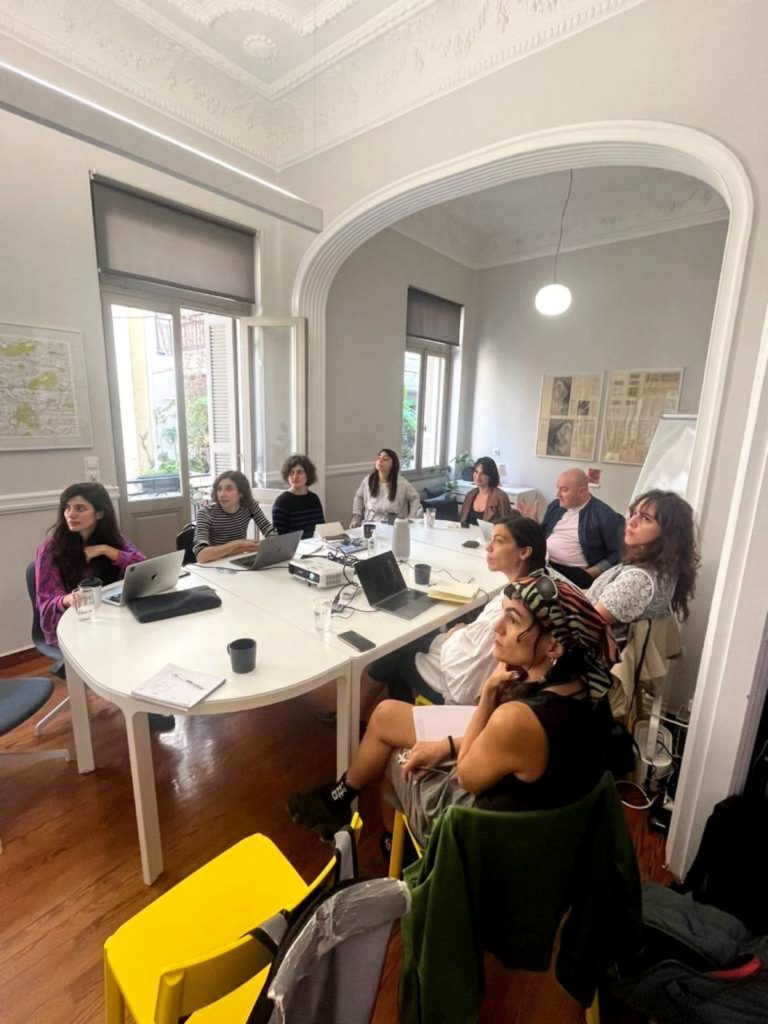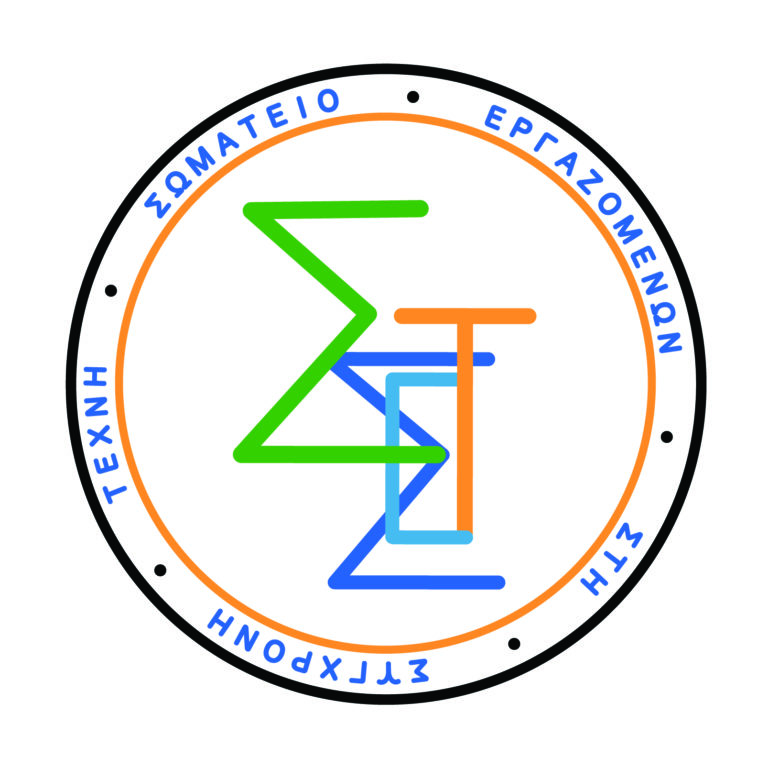Interview 1 of the series: Art at Work
Author: Danai Giannoglou
In March 2020, during the first lock-down that followed the out-break of Covid-19 in Europe, Athens-based curator and cultural worker Myrto Katsimicha makes the instinctive and reflexive choice of creating a private Facebook group where cultural workers could exchange and share on how the pandemic was affecting their professional lives and financial situations. Unknowingly, Myrto Katsimicha had planted the seed for the creation of SEST–Greece’s first union of workers in contemporary art, of which she is now president.

Union of Contemporary Art Workers – © SEST
Danai Giannoglou: Myrto, can you tell me exactly what happened in March 2020, how did it all start?
Myrto Katsimicha: For me it all began quite paradoxically. I had just started working at Onassis AiR as a Programme Documentation & Communication Officer so, in spite of the rough economic and financial conditions that the pandemic had brought, my own livelihood was not threatened as it happened in other cases. However, most of the people in my immediate network who were depending on project-based commissions and collaborations were struggling tremendously while everything was shutting down. That was the moment I felt that we had to support each other and make an effort to understand the ways in which this new condition was affecting each and every one of us working in the same field. So, I created a small private Facebook group, intended for friends and collaborators from the art sector, to share any opportunities and needs they might have.
Simultaneously, a colleague, Kiriakos Spirou who is the founding editor of und.Athens had uploaded a poll, inviting people to take positions with regards to the stance the Greek Ministry of Culture should take vis-à-vis cultural workers. We got in touch as our initiatives were sharing grounds and we made the Facebook group public as it felt that more and more people were in need of such a platform. A few days later, in a very spontaneous way, we decided to call an online general assembly. During our second meeting, different needs became apparent and we split into working groups. One of the working groups was called ‘how to unionise’ and it gathered individuals who were interested in understanding what it would mean to unionise and who thought that this was the most viable option regarding the situation. All working groups were meeting weekly in order to exchange on their progress and new members were constantly joining the assemblies. At the same time, we would often invite representatives of other European grassroot organisations or unions in order to get a glimpse of what was going on in other countries and how cultural workers were organising, defending, and claiming their rights abroad.
I also joined the ‘how to unionise’ group because, especially as a curator, I felt I was missing the representation of my profession at a political level. Most artists in Greece have the option of joining EETE (Chamber of Fine Arts of Greece) which has a certain political strength, but curators and other professionals in the arts cannot join.
Does SEST, the union we know today, stem from the ‘how to unionise’ group of these first self-organised and open general assemblies? What happened after the initial period?
MK: In a certain way, yes, it stems from that working group along with the research and drive that was fostered by some other working groups and individuals. After almost four months of countless online meetings, research, and reporting, in July 2020, when experienced a first relaxation of the Covid-19 measures, we were all exhausted by the effort and things didn’t seem so urgent anymore. Most working groups dissolved, same as the weekly general assemblies and for many people it was suddenly impossible to continue juggling these activities together with everything else, or simply disagreed or lost interest. Kiriakos Spirou also stepped down at that point. However, the ‘how to unionise’ group proved to have laid solid foundations, thus being the only group that continued running after that summer. The discussion was no longer theoretical and for the people that continued gathering the goal of creating a cultural workers union was then clear. I kept organising and moderating these meetings together with Katerina Samara, who has been part of this process from day one, and gradually the group got bigger as the existing members started bringing new ones.

Code of Ethics workshop' with ethics practitioner and art collector Piergiorgio Pepe and members of the Union, Athens, November 2023 – © Kosmas Nikolaou
What’s the path to arrive here and now, having a one-year-old cultural workers’ union?
MK: In the preparation phase we focused on two main tasks, while maintaining our monthly online meetings. On the one hand, there was a group that was developing the criteria for joining the union, which mostly had to do with finding a balance between an inclusive union and one that would actually be able to represent its members. On the other hand, the second group was working on drafting the union’s statute. Both of these groups were doing research within other similar structures. Once we reached the point when both these documents were drafted and presentable, we invited a lawyer to advise on the legal and formal aspects.
In June 2021, twenty-eight of us (the legal minimum number of people demanded for establishing a union in Greece is twenty) gathered and signed the Statute that was then submitted to the court. Due to unforeseen changes in the Greek legislation, the union’s registration was stalled and we only managed to complete it in October 2022. During all this time of bureaucratic hurdles, we continued to meet and work on different tasks such as developing our website and our communication and fair pay strategies. Not being able to see the result of this very long struggle was tiring and frustrating, but in the end, it all worked out.
What do you think is the gap that this union fills in the Greek cultural ecosystem?
MK: When you form an organisation such as a union, what you do is that you give visibility to the workers. A union offers representation on a political level for the collective bargain of working conditions. This was exactly what I felt was missing from the country when I returned from my studies: the recognition of being a professional and the rights that come with this recognition. Many people–and policies–follow this misconception that the people who work in the cultural sector are part of it only because they really want or like it. They consider it a vocation and not something that people do for a living. Especially when you are young, you encounter a lot of exploitative behaviour based on the aforementioned premises, and others. When I was a younger professional, I felt that I didn’t have the network to speak up about these issues. Having a union in place is having a structure that can prevent these things from happening or at least support you when they happen. I felt this lack of structure that could protect me, my co-workers, and my collaborators from these situations. Things will not change in a day, but a union can create a framework for legislative changes and exercise political pressure. And it was clear that it wasn’t only curators who were missing this, but also artists. Of course, we have different needs and challenges in our activities, but we work very closely and we need to connect more, in order to make this scene stronger.
What are the challenges of applying methodological tools that have to do with horizontality, self-organisation and grassroots legacies to an entity that has a very official form and carries a lot of responsibility?
MK: The matter of scale is of great importance in this equation. At the moment, we are still a fairly small union, which allows us to work with these tools. It also has to do with the members themselves. Right now, a great part of our members is involved and active. I must admit that this very organic yet conscious decision of working horizontally is slowing down all processes, but still, we find it extremely important. Of course, the general assembly is our decision-making instrument, but we’ve also given a lot of responsibility to the members that wish to be involved by ‘breaking-down’ the research and day-to-day tasks to working groups. We don’t know what the future holds though. Οne day we might see the union being organised in a more bureaucratic and top-down way. However, our statute will always protect collective work, since the existence of working groups is stipulated in it.

Logo – © SEST
In SEST’s experience, what is the relationship between independent initiatives and the institutional framework?
MK: Even though SEST borrows many of the self-organisation and independent initiative tools, it is in fact an institution, a small scale one, but nevertheless an institution, and this is because there was no other way of forming a union that could be recognised by the Greek State. We wanted to have an official formation, but from early on we had discussions about how to ‘bend’ or ‘break’ the hierarchies that come with it. Unfortunately, the existing structures do not allow a lot of bending or breaking, they don’t allow for officially horizontality-structured organisations. For example, we looked into ways of establishing a union without a board, but with a rolling shift in roles between the members. This was in no way possible. To have a union you have to have a board and a president (aka a legal representative). However, in the way we organise everything else within the union one might say that we are trying to hijack this imposed hierarchy.
What is happening now and what are your hopes and visions for the future of SEST?
MK: In our first general assembly as an established union, we decided to focus on three different directions. The first one was drafting a code of conduct, so setting an ethical framework for our sector; the second one was creating the internal regulations, an operational document that outlines what we do and how we do it, that makes our activities and process more transparent to our members; and the third one was setting up different working groups that allow us to be open and to conduct research on critical issues that relate to our sector i.e. fair pay, health insurance, contracts and agreements of employment, etc. As you see, some of these goals are more long-term than others.
We are only one year old, so in a way we are still laying the groundwork for this structure that will be the union. In every general assembly, we’ll be setting new goals so as to keep up with current developments and needs. Ultimately, we want to work towards a safer environment that is characterised by fair practices, collegiality, and solidarity in the arts. These are the first baby steps.
Published on May 14th, 2024
About the author:
Danai Giannoglou is a curator, writer and editor currently living and working independently between Athens and Amsterdam. Danai is the co-founder and curator of Enterprise Projects, a project space in Athens that has been functioning independently and periodically since September 2015, as well as the editor of Enterprise Projects Journal, a publishing initiative by Enterprise Projects in the form of a bilingual online publication of newly commissioned theoretical and research essays.